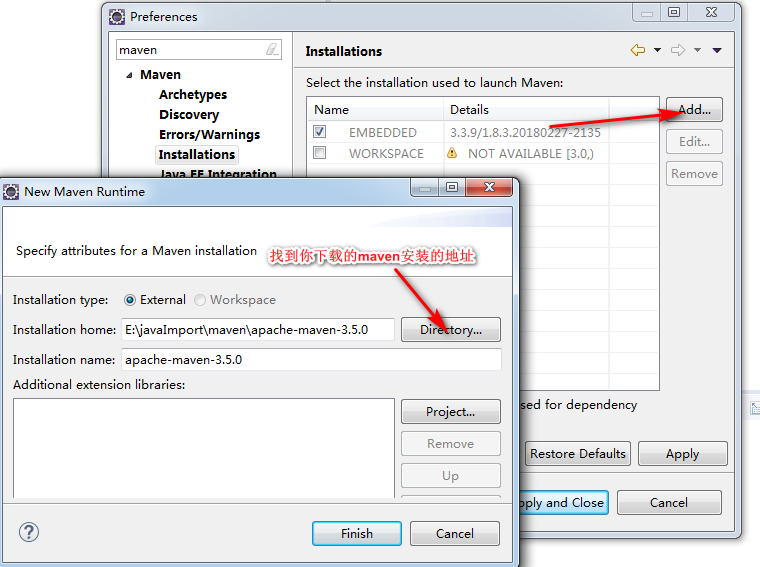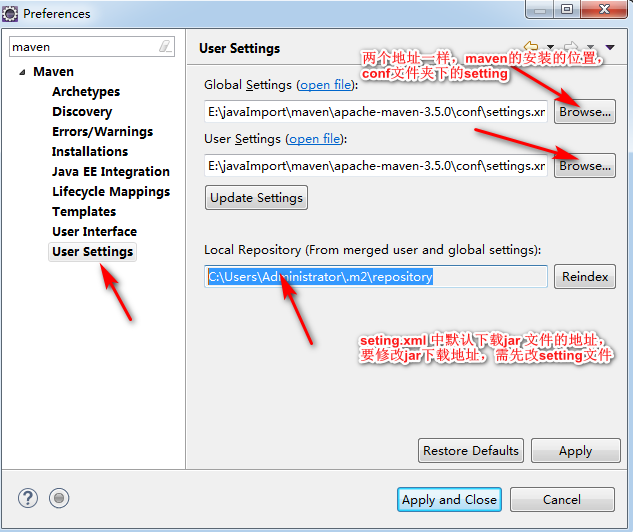eclipse ------------- 安装maven ,配置setting文件
1、设置maven路径
Window->Preferences->Maven->Installations->

选择maven的路径,如果原来有低版本的建议删除
选择好后点击finish

设置仓库路径
菜单->Window->Preferences->Maven->User Settings->
Global Settings 和 User Settings都使用,你maven安装的地方,找conf 文件夹下的 settings.xml
E:\javaImport\maven\apache-maven-3.5.0\conf\settings.xml
点击一下Reindex,确保 local Repository:


修改jar文件下载地址,修改setting.xml 文件
该地址
<localRepository>d:/maven/repository</localRepository>
maven 会默认从maven官方提供的服务器下载jar包。
而官方服务器在国外,由于,网速很慢,而且容易卡断。 为了便于快速下载相关jar包,可以使用国内maven 阿里云的下载地址
<mirror> <id>alimaven</id> <mirrorOf>central</mirrorOf> <name>aliyun maven</name> <url>http://maven.aliyun.com/nexus/content/repositories/central/</url> </mirror>
完整的setting文件
链接:https://pan.baidu.com/s/1YxRftJmdv714_LoWqeTUmg
提取码:92js
1 <?xml version="1.0" encoding="UTF-8"?> 2 3 <!-- 4 Licensed to the Apache Software Foundation (ASF) under one 5 or more contributor license agreements. See the NOTICE file 6 distributed with this work for additional information 7 regarding copyright ownership. The ASF licenses this file 8 to you under the Apache License, Version 2.0 (the 9 "License"); you may not use this file except in compliance 10 with the License. You may obtain a copy of the License at 11 12 http://www.apache.org/licenses/LICENSE-2.0 13 14 Unless required by applicable law or agreed to in writing, 15 software distributed under the License is distributed on an 16 "AS IS" BASIS, WITHOUT WARRANTIES OR CONDITIONS OF ANY 17 KIND, either express or implied. See the License for the 18 specific language governing permissions and limitations 19 under the License. 20 --> 21 22 <!-- 23 | This is the configuration file for Maven. It can be specified at two levels: 24 | 25 | 1. User Level. This settings.xml file provides configuration for a single user, 26 | and is normally provided in ${user.home}/.m2/settings.xml. 27 | 28 | NOTE: This location can be overridden with the CLI option: 29 | 30 | -s /path/to/user/settings.xml 31 | 32 | 2. Global Level. This settings.xml file provides configuration for all Maven 33 | users on a machine (assuming they're all using the same Maven 34 | installation). It's normally provided in 35 | ${maven.conf}/settings.xml. 36 | 37 | NOTE: This location can be overridden with the CLI option: 38 | 39 | -gs /path/to/global/settings.xml 40 | 41 | The sections in this sample file are intended to give you a running start at 42 | getting the most out of your Maven installation. Where appropriate, the default 43 | values (values used when the setting is not specified) are provided. 44 | 45 |--> 46 <settings xmlns="http://maven.apache.org/SETTINGS/1.0.0" 47 xmlns:xsi="http://www.w3.org/2001/XMLSchema-instance" 48 xsi:schemaLocation="http://maven.apache.org/SETTINGS/1.0.0 http://maven.apache.org/xsd/settings-1.0.0.xsd"> 49 <!-- localRepository 50 | The path to the local repository maven will use to store artifacts. 51 | 52 | Default: ${user.home}/.m2/repository 53 54 --> 55 <localRepository>d:/maven/repository</localRepository> 56 57 <!-- interactiveMode 58 | This will determine whether maven prompts you when it needs input. If set to false, 59 | maven will use a sensible default value, perhaps based on some other setting, for 60 | the parameter in question. 61 | 62 | Default: true 63 <interactiveMode>true</interactiveMode> 64 --> 65 66 <!-- offline 67 | Determines whether maven should attempt to connect to the network when executing a build. 68 | This will have an effect on artifact downloads, artifact deployment, and others. 69 | 70 | Default: false 71 <offline>false</offline> 72 --> 73 74 <!-- pluginGroups 75 | This is a list of additional group identifiers that will be searched when resolving plugins by their prefix, i.e. 76 | when invoking a command line like "mvn prefix:goal". Maven will automatically add the group identifiers 77 | "org.apache.maven.plugins" and "org.codehaus.mojo" if these are not already contained in the list. 78 |--> 79 <pluginGroups> 80 <!-- pluginGroup 81 | Specifies a further group identifier to use for plugin lookup. 82 <pluginGroup>com.your.plugins</pluginGroup> 83 --> 84 </pluginGroups> 85 86 <!-- proxies 87 | This is a list of proxies which can be used on this machine to connect to the network. 88 | Unless otherwise specified (by system property or command-line switch), the first proxy 89 | specification in this list marked as active will be used. 90 |--> 91 <proxies> 92 <!-- proxy 93 | Specification for one proxy, to be used in connecting to the network. 94 | 95 <proxy> 96 <id>optional</id> 97 <active>true</active> 98 <protocol>http</protocol> 99 <username>proxyuser</username> 100 <password>proxypass</password> 101 <host>proxy.host.net</host> 102 <port>80</port> 103 <nonProxyHosts>local.net|some.host.com</nonProxyHosts> 104 </proxy> 105 --> 106 </proxies> 107 108 <!-- servers 109 | This is a list of authentication profiles, keyed by the server-id used within the system. 110 | Authentication profiles can be used whenever maven must make a connection to a remote server. 111 |--> 112 <servers> 113 <!-- server 114 | Specifies the authentication information to use when connecting to a particular server, identified by 115 | a unique name within the system (referred to by the 'id' attribute below). 116 | 117 | NOTE: You should either specify username/password OR privateKey/passphrase, since these pairings are 118 | used together. 119 | 120 <server> 121 <id>deploymentRepo</id> 122 <username>repouser</username> 123 <password>repopwd</password> 124 </server> 125 --> 126 127 <!-- Another sample, using keys to authenticate. 128 <server> 129 <id>siteServer</id> 130 <privateKey>/path/to/private/key</privateKey> 131 <passphrase>optional; leave empty if not used.</passphrase> 132 </server> 133 --> 134 </servers> 135 136 <!-- mirrors 137 | This is a list of mirrors to be used in downloading artifacts from remote repositories. 138 | 139 | It works like this: a POM may declare a repository to use in resolving certain artifacts. 140 | However, this repository may have problems with heavy traffic at times, so people have mirrored 141 | it to several places. 142 | 143 | That repository definition will have a unique id, so we can create a mirror reference for that 144 | repository, to be used as an alternate download site. The mirror site will be the preferred 145 | server for that repository. 146 |--> 147 <mirrors> 148 <!-- mirror 149 | Specifies a repository mirror site to use instead of a given repository. The repository that 150 | this mirror serves has an ID that matches the mirrorOf element of this mirror. IDs are used 151 | for inheritance and direct lookup purposes, and must be unique across the set of mirrors. 152 | 153 <mirror> 154 <id>mirrorId</id> 155 <mirrorOf>repositoryId</mirrorOf> 156 <name>Human Readable Name for this Mirror.</name> 157 <url>http://my.repository.com/repo/path</url> 158 </mirror> 159 --> 160 <mirror> 161 <id>alimaven</id> 162 <mirrorOf>central</mirrorOf> 163 <name>aliyun maven</name> 164 <url>http://maven.aliyun.com/nexus/content/repositories/central/</url> 165 </mirror> 166 167 </mirrors> 168 169 <!-- profiles 170 | This is a list of profiles which can be activated in a variety of ways, and which can modify 171 | the build process. Profiles provided in the settings.xml are intended to provide local machine- 172 | specific paths and repository locations which allow the build to work in the local environment. 173 | 174 | For example, if you have an integration testing plugin - like cactus - that needs to know where 175 | your Tomcat instance is installed, you can provide a variable here such that the variable is 176 | dereferenced during the build process to configure the cactus plugin. 177 | 178 | As noted above, profiles can be activated in a variety of ways. One way - the activeProfiles 179 | section of this document (settings.xml) - will be discussed later. Another way essentially 180 | relies on the detection of a system property, either matching a particular value for the property, 181 | or merely testing its existence. Profiles can also be activated by JDK version prefix, where a 182 | value of '1.4' might activate a profile when the build is executed on a JDK version of '1.4.2_07'. 183 | Finally, the list of active profiles can be specified directly from the command line. 184 | 185 | NOTE: For profiles defined in the settings.xml, you are restricted to specifying only artifact 186 | repositories, plugin repositories, and free-form properties to be used as configuration 187 | variables for plugins in the POM. 188 | 189 |--> 190 <profiles> 191 <!-- profile 192 | Specifies a set of introductions to the build process, to be activated using one or more of the 193 | mechanisms described above. For inheritance purposes, and to activate profiles via <activatedProfiles/> 194 | or the command line, profiles have to have an ID that is unique. 195 | 196 | An encouraged best practice for profile identification is to use a consistent naming convention 197 | for profiles, such as 'env-dev', 'env-test', 'env-production', 'user-jdcasey', 'user-brett', etc. 198 | This will make it more intuitive to understand what the set of introduced profiles is attempting 199 | to accomplish, particularly when you only have a list of profile id's for debug. 200 | 201 | This profile example uses the JDK version to trigger activation, and provides a JDK-specific repo. 202 <profile> 203 <id>jdk-1.4</id> 204 205 <activation> 206 <jdk>1.4</jdk> 207 </activation> 208 209 <repositories> 210 <repository> 211 <id>jdk14</id> 212 <name>Repository for JDK 1.4 builds</name> 213 <url>http://www.myhost.com/maven/jdk14</url> 214 <layout>default</layout> 215 <snapshotPolicy>always</snapshotPolicy> 216 </repository> 217 </repositories> 218 </profile> 219 --> 220 221 <!-- 222 | Here is another profile, activated by the system property 'target-env' with a value of 'dev', 223 | which provides a specific path to the Tomcat instance. To use this, your plugin configuration 224 | might hypothetically look like: 225 | 226 | ... 227 | <plugin> 228 | <groupId>org.myco.myplugins</groupId> 229 | <artifactId>myplugin</artifactId> 230 | 231 | <configuration> 232 | <tomcatLocation>${tomcatPath}</tomcatLocation> 233 | </configuration> 234 | </plugin> 235 | ... 236 | 237 | NOTE: If you just wanted to inject this configuration whenever someone set 'target-env' to 238 | anything, you could just leave off the <value/> inside the activation-property. 239 | 240 <profile> 241 <id>env-dev</id> 242 243 <activation> 244 <property> 245 <name>target-env</name> 246 <value>dev</value> 247 </property> 248 </activation> 249 250 <properties> 251 <tomcatPath>/path/to/tomcat/instance</tomcatPath> 252 </properties> 253 </profile> 254 --> 255 </profiles> 256 257 <!-- activeProfiles 258 | List of profiles that are active for all builds. 259 | 260 <activeProfiles> 261 <activeProfile>alwaysActiveProfile</activeProfile> 262 <activeProfile>anotherAlwaysActiveProfile</activeProfile> 263 </activeProfiles> 264 --> 265 </settings>
在配置一下

点击应用就配置好了
